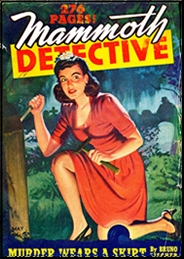Sun 16 Jan 2022

BRUNO FISCHER – The Hornets’ Nest. Rick Train #1. Dell #79, mapback edition, [date?]. Cover by Gerald Gregg. Previously published in hardcover by Morrow, 1944. Originally appeared in Mammoth Detective, May 1944, as “Murder Wears a Skirt.”
While this was newspaper reporter Rick Train’s first appearance in print, he could have just as well have been a private eye with one last case before he’s called up by the army as part of the war effort. Not only is he fairly known as a guy who’s broken or solved several big cases, he’s also noted as a collector of all kinds of guns as well as being a crack shot with all of them.
With only a week before he reports for duty, he finds himself up to his ears in yet another case of double homicide, beginning with a somewhat forlorn young girl with a story she’d like the Train’s paper to buy. Turning her down because he’s already cleared out his desk, he soon learns that she’s been shot and killed soon after leaving him. He doesn’t have a client, but he is of course committed to finding her killer.

The case, as it turns out, involves an estate that’s up for grabs, with no less than three claimants for the money. All three have good credentials. The question is which one wants the money more than the others? And all the while Train is trying to answer that particular question, he soon becomes the target of the killer himself, presumably – a woman who seems to be as good with a gun as he is.
The story is competently told without being anything close to exceptional, with characterization next to nil. As a pulp writer, though, with lots of tales well under his belt, Fischer’s prose is smooth enough to keep this one moving. Until that is, when it comes to the final solution and explanation. Without the reader even noticing, the story turns out to have been more complicated than he or she probably realized: it takes eleven full pages to get through Train’s explanation of everything that had just happened in the previous 180.
Never mind that. As a detective Train is good enough that I had to wonder why his second and final appearance was only in Kill to Fit, a digest-sized paperback original published by a third-rate company called Five Star Mysteries (1946). (Whether that one also first appeared in pulp magazine under a different name, I do not know.)
January 16th, 2022 at 11:57 pm
Not long after this Fisher had a brief shot in hard-covers with some good mysteries and I suspect Rick Train was just too pulp to come along for the ride.
Ironically his greatest success would be in paperback originals where he would go back to his pulp roots, even suggesting some of his Russell Gray work in the weird menace genre with the suggestion of kinky sex — at least on the covers and in the description on the back cover.
January 17th, 2022 at 12:00 am
I realize this one was published in hardcover, but it sounds far pulpier than his primary hard-cover series mysteries about an agency tec.
January 17th, 2022 at 12:40 am
That was probably NYC private eye Ben Helm, who was in six of Fischer’s mystery novels, mostly from the late 40s. I don’t think he ever lost his primary pulp beginnings. Less so with the hardcovers, but more so with the paperback originals he starting in the 1950s, mostly for Gold Medal.
I found a review I wrote of another Fischer book I read many years ago:
https://mysteryfile.com/blog/?p=531
Here’s the first few lines:
BRUNO FISCHER – The Girl Between.
Gold Medal 1054. Paperback original; 1st printing, 1960.
Here’s a pulp story that’s designed to tell you what really goes on inside the traditional smoke-filled room of small-time politics.
January 17th, 2022 at 1:58 am
The Helm titles I read were, while still pulp related, pretty straight mystery in a slightly more serious vein than most of Fischer’s work I’ve read. He seemed to be trying for a slightly more sophisticated audience in them than his earlier pulp and later paperback work.
January 17th, 2022 at 7:10 pm
What exactly is that I am seeing on that first book cover displayed above for “Hornet’s Nest”?
I hesitate to conject. It looks like a …bratwurst …with a needle stuck through it? Or, pinned to a memo spike on a desk?
January 17th, 2022 at 7:18 pm
The painting is too dark to make out clearly, but having the book in hand so I can squint at it close up, no it’s not a bratwurst. It is … a hornet! Take another look and I think you’ll see its wings.
I don’t think the title is anything other than symbolic, as in “stirring up a hornets’ nest.” I don’t think any hornets were killed in the writing of this book.